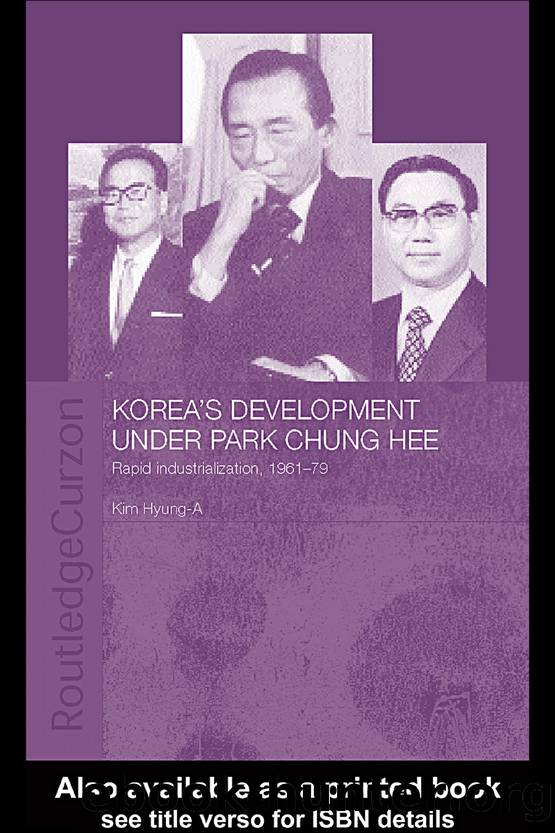Korea's Development Under Park Chung Hee by Kim Hyung-A

Author:Kim, Hyung-A
Language: eng
Format: epub
Publisher: Taylor & Francis (CAM)
The purpose of the Factory SaemaÅl Movement, in Park's words, was to instill a new family culture within the corporate state, incorporating âfamily-like laborâmanagement ties,â the philosophical nexus being that âmy cooperation [H11005] my family [H11005] my fatherland.â This Korean-style concept was adopted as an official guideline for the Urban SaemaÅl Movement by the Ministry of the Interior. The Factory SaemaÅl Movement was also a mechanism used by Park for managing labor disputes and maintaining industrial order, which proved particularly effective during the 1973â4 oil crisis.11 Unlike the SaemaÅl Movements of other public and social organizations, the Factory SaemaÅl Movement was coordinated independently by the Korean Chamber of Commerce, with a chapter established in each province or city or equivalent area. Similarly, there were a total of twelve Factory SaemaÅl education centers throughout the country. Of these, two centers, located in Seoul and Pusan, were run by the Ministry of Commerce and Industry, which managed to train a total of 46,531 âhigh and middle level managersâ between 1973 and 1979. During the same period, the other ten âprivateâ centers, including Ganahan Farmersâ Schools, trained a total of 144,733 leaders of the Factory SaemaÅl Movement (Ki Hyuk Park 1981: 185).
Upon the completion of their training, these leaders were responsible for organizing training for their fellow workers in their respective factories. The training aimed, as already noted, to promote harmony and unity between employers and employees, while increasing productivity. Its ideals were reflected in the slogan, âSawÅnÅl kajok châÅrÅm, hoesarÅl naejip châÅrÅmâ (Employees like family; the company like my home).12 This slogan, and others like it, spread widely among large-scale Korean chaebÅl companies throughout the late 1970s and 1980s, and undoubtedly served a purpose, especially for the state's control over the labor movement. In fact, many key policy-makers of the time claim that the phenomenal success of the HCI program was due largely to the Factory SaemaÅl Movement, particularly in its âattitudeâ training for management. This view, of course, was not that of the majority of workers, the âminjung,â who believed that the success of the HCI program was due to their unmitigated exploitation. The increasing industrial disputation and related activity of the labor movement in the late 1970s, especially the female factory workersâ struggle that ultimately played an important part in Park's demise (see Chapter 7), reflected the severity of the impasse between the stateâemployers and workers. As a means to solving the mounting conflict, Park made SaemaÅl Leadersâ Training compulsory, the South Korean version of Kim Il Sung's political thought training of the masses.
Download
This site does not store any files on its server. We only index and link to content provided by other sites. Please contact the content providers to delete copyright contents if any and email us, we'll remove relevant links or contents immediately.
| Anthropology | Archaeology |
| Philosophy | Politics & Government |
| Social Sciences | Sociology |
| Women's Studies |
The Secret History by Donna Tartt(16627)
The Social Justice Warrior Handbook by Lisa De Pasquale(11489)
Thirteen Reasons Why by Jay Asher(7788)
This Is How You Lose Her by Junot Diaz(5774)
Weapons of Math Destruction by Cathy O'Neil(5038)
Zero to One by Peter Thiel(4824)
The Myth of the Strong Leader by Archie Brown(4789)
Promise Me, Dad by Joe Biden(4449)
Beartown by Fredrik Backman(4419)
Stone's Rules by Roger Stone(4416)
How Democracies Die by Steven Levitsky & Daniel Ziblatt(4399)
The Fire Next Time by James Baldwin(4343)
100 Deadly Skills by Clint Emerson(4079)
A Higher Loyalty: Truth, Lies, and Leadership by James Comey(4033)
Rise and Kill First by Ronen Bergman(4012)
The David Icke Guide to the Global Conspiracy (and how to end it) by David Icke(3883)
The Farm by Tom Rob Smith(3872)
Secrecy World by Jake Bernstein(3783)
The Doomsday Machine by Daniel Ellsberg(3731)
